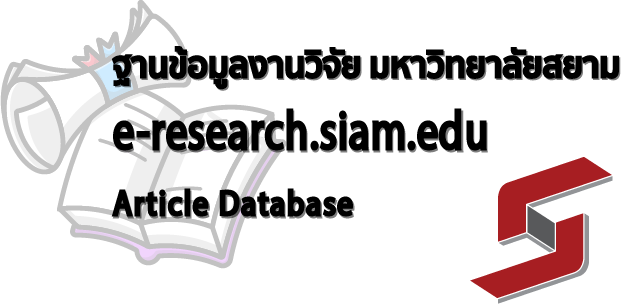- KB Home
- หลักสูตรระดับบัณฑิตศึกษา|Graduate Schools
- หลักสูตรปริญญาโท|Masters Degree
- IMBA
- Study about the Belt and Road’s Impact on China and the World
| Project Title: | Study about the Belt and Road’s Impact on China and the World |
| Author: | Miss Yuxuan Lin |
| Advisor: | Assoc. Prof. Dr. Jomphong Mongkhonvanit |
| Degree: | Master of Business Administration |
| Major: | International Master of Business Administration |
| Faculty: | Graduate Schools |
| Academic year: | 2017 |
Citation
Yuxuan, Lin. (2017). Study about the belt and road’s impact on China and the world. (Master’s independent study). Bangkok: Master in Business Administration, Siam University.
Abstract
In September 2013, during his visit to Kazakhstan, Chinese President Xi Jinping first proposed the establishment of a “Silk Road Economic Belt”. In October 2013, President Xi visited the ASEAN countries and proposed in parliamentary speech held in Indonesia that China should jointly build “the 21st Century Maritime Silk Road” with the ASEAN countries. Subsequently, the decision of pushing forward the construction of the Silk Road Economic Belt and the Maritime Silk Road and forming a new pattern of opening in all directions was put into the “Decision of the CPC Central Committee on Several Important Issues concerning the Overall Deepening of Reform”. At this point, the “Silk Road Economic Belt” and “21st Century Maritime Silk Road” officially upgraded to the national top design and is called “the Belt and Road”. The proposed strategy was not only in line with the current international situation and the changes in the international situation, but also was the time-selected option for resolving the stage issue of national development during the period of social transformation in China. The purpose of this study is to fully analyze and summarize the theoretical aspects of the “Belt and Road” strategy and its implications. From the perspective of differential order pattern, this paper analyzes the policy design of this strategy. Taking China as a perspective, the study makes a longitudinal comparison between” The Belt and Road” strategy and the ancient Silk Road and compares them horizontally with the TPP(Trans-Pacific Partnership). It also analyzes the political, economic, cultural, international, regional and domestic levels of the countries along the line the challenges faced include the game between the United States, Russia, India and other countries, the attitude in multi-bilateral cooperation and the role played by regional development. In addition, this study introduces the sociological theory of “difference order pattern”. By analyzing the data of the difference with the orderliness and spatial distribution of the industrial advancement in the Belt and Road strategy of China at present, based on the strategic framework of “One Belt and One Road”, the study clarifying the possible implications and problems facing China’s politics, economy, culture and country image, and trying to make some suggestions. On the political side, the Belt and Road policy will consolidate China’s political status and help China to development of multilateral relations. On the economy side, the Belt and Road policy will help China Cut excessive industrial capacity and benefit all “Belt and Road” members. On the culture side, The Belt and Road will Chinese culture output and improve cultural influence.
Keywords: Belt and Road, industry promotion, development strategy.
Study on Methods for Human Resources Management of Enterprise Based on Information Technology
International Master in Business Administration (IMBA), Siam University, Bangkok, Thailand
Related by Advisor:
- The Status and Prospects of Internet Finance Credit Services at Bangkok: A Case Study Based on Ant Check Later
- Research of the tourism industry development strategy in Bangkok of Thailand
- The relationship between accounting professional judgment ability and moral philosophy: Obedience pressure, self-interest motivation and professional commitment as moderating variables
- Research on marketing strategy of large business hotels in Thailand
- Research on competitiveness of export trade and strategy of Thai Mango
- Thai consumers’ perception and evaluation of Chinese products


